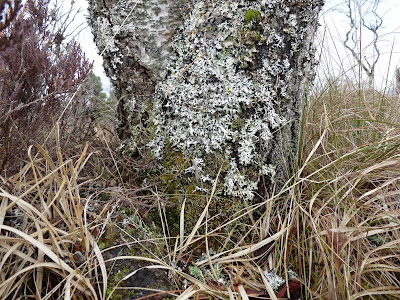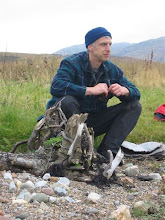


 This rare species and habitat monitoring is not always what it is cut out to be. Last week I was out on the Moss monitoring the water levels in the peat. This means an 8 hour, 12 mile slog in a big circle around the bog visiting all 22 water measuring devices to see how wet the Moss is and how weel our "making the bog wetter work " is going. As it was the right time of year I decided to check for one of our rarest moths, the Rannoch Brindled Beauty. This moth is an early one coming out of its pupae in March and April to meet up, mate and lay its eggs on bog myrtle. As it is a cold time of year the moth wears a thick furry coat to keep warm. The males have a fetching grey and orange mottled look that matches perfectly the base of the birch trees where they sit waiting for a warmer day. All the females have to do is crawl from the ground where they have pupated up a nearby birch tree and wait for a male to turn up. For this they don't need wings and so don't have any. However this means that with their thick fur coat they look very like a small bit of belly button fluff . So you can imagine the job, looking for a bit of fluff about 1 cm long on the base of trees across a nature rerserve the size of 2200 football pitches. And I didn't find any ! The pay back came in the form of a pine beauty moth and 3 golden horns moths, both common species but still beautiful. And the base of birch trees are not too shaby on the moss being encrusted with lichens and algae. But after 12 miles on the bog I was walking a bit funny the next day.
This rare species and habitat monitoring is not always what it is cut out to be. Last week I was out on the Moss monitoring the water levels in the peat. This means an 8 hour, 12 mile slog in a big circle around the bog visiting all 22 water measuring devices to see how wet the Moss is and how weel our "making the bog wetter work " is going. As it was the right time of year I decided to check for one of our rarest moths, the Rannoch Brindled Beauty. This moth is an early one coming out of its pupae in March and April to meet up, mate and lay its eggs on bog myrtle. As it is a cold time of year the moth wears a thick furry coat to keep warm. The males have a fetching grey and orange mottled look that matches perfectly the base of the birch trees where they sit waiting for a warmer day. All the females have to do is crawl from the ground where they have pupated up a nearby birch tree and wait for a male to turn up. For this they don't need wings and so don't have any. However this means that with their thick fur coat they look very like a small bit of belly button fluff . So you can imagine the job, looking for a bit of fluff about 1 cm long on the base of trees across a nature rerserve the size of 2200 football pitches. And I didn't find any ! The pay back came in the form of a pine beauty moth and 3 golden horns moths, both common species but still beautiful. And the base of birch trees are not too shaby on the moss being encrusted with lichens and algae. But after 12 miles on the bog I was walking a bit funny the next day.

